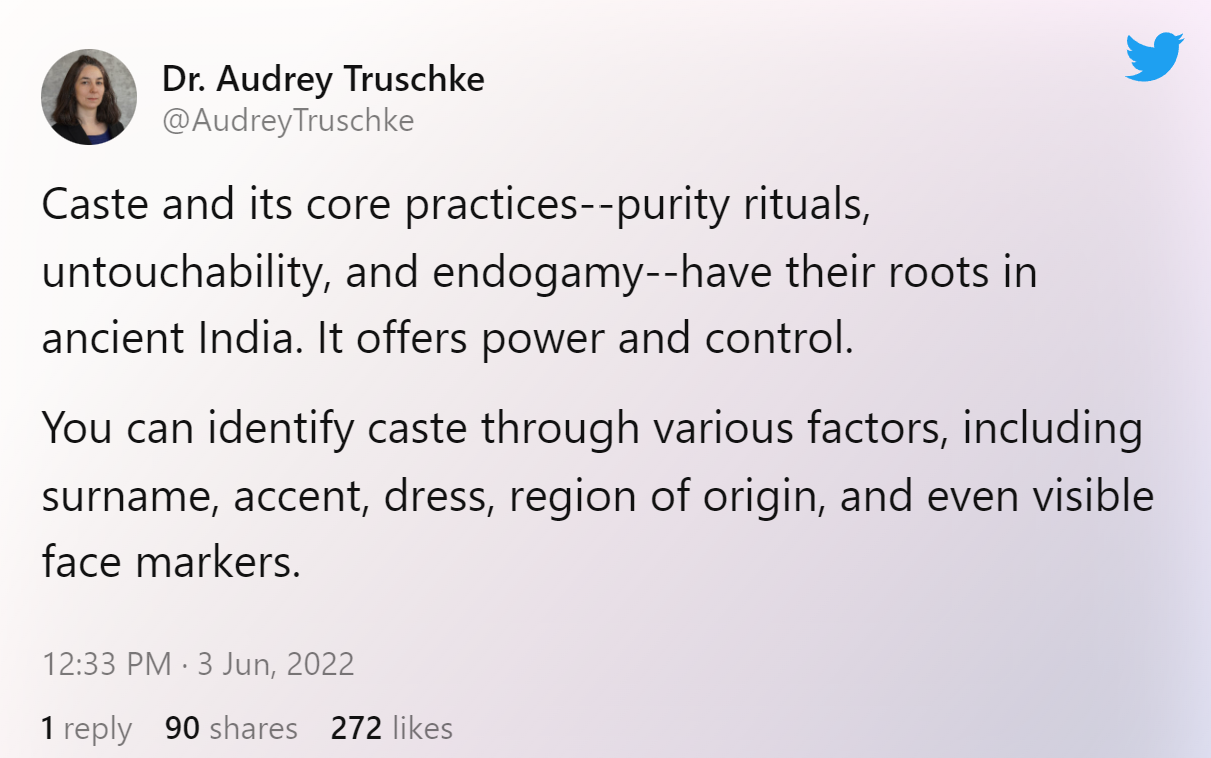The Caste Politics in USA
Tags: caste

I grew up in India and am still unable to grasp the complexity of the caste system. While there is still caste discrimination plaguing India, the country with a population of over a billion people, diverse languages, cultures, and levels of prosperity does not have a consensus on caste. However, it is unfortunate that a white professor in the US, who has lived all her life outside India, seems to claim expert knowledge on caste.
 |
How does one identify caste? Any Indian would tell you that it is by your last name. Since antiquity, last names have been associated with trades, and thus become a de facto marker of caste.
However, to claim that caste can be identified by visible markers is scientifically nonsensical. Opinions are not scientific facts, and there is no study that claims that caste is unique like race. Some caste activists claim that lower-caste individuals have a darker complexion than upper-caste individuals. However, not only is this claim racist, but it is also devoid of any rational basis. Of course, some individuals want to conflate caste with race so that caste politics become more potent in the US.
Thenmozhi Soundararajan, the founder of Equality Labs1, has made some troubling statements, such as claiming that the Nazis in Europe are actually upper-caste Indians. Such statements are not only factually incorrect but also insensitive and inflammatory. Furthermore, claiming that every act of Hindu scripture has brought nothing but violence and pain is a gross oversimplification and ignores the diverse interpretations and practices within Hinduism.
Caste is a complex issue in India, and there are varying opinions on how to address it. Many centrist and right-wing Hindus believe that Hinduism can be reformed, similar to how Christianity has undergone changes over time. They argue that caste discrimination is a result of people misinterpreting and misusing Hindu teachings, and that reforming the religion can help address this issue. On the other hand, the left in India believes that caste is inherent to Hinduism and that dismantling the caste system requires dismantling the religion itself. This view asserts that caste is a tool of oppression and social control, and cannot be separated from the religion that gave rise to it. There are also some extreme views, such as the suggestion by Prof Dwivedi that a French-style revolution is necessary to eradicate caste in India2.
It's important to note that when Professor Dwivedi suggested a French-style revolution as a solution to India's caste stasis, she was essentially advocating for the violent overthrow of the upper caste Hindus. The French Revolution was known for its violent and bloody nature, with the guillotine being used to execute thousands of people, including the aristocrats. Similarly, in India, a revolution of this nature would involve the mass killing of upper caste Hindus, who are seen as the oppressors in the caste system. While dismantling the caste system is necessary, advocating for violence against a particular group of people is not the solution.
It's crucial to find peaceful and non-violent ways to dismantle the caste system and create a more equitable society for all. These differing political views on caste in India are not only affecting domestic politics but also spilling over into the US political landscape.
The California Civil Rights Department dismissed its case against two Cisco engineers who allegedly engaged in caste bias. However, even before the verdict, international and left/liberal media in India drew prima facie conclusions that it was a caste discrimination case.
Historical prejudice against India and Hindus is still prevalent, as evidenced by British historian James Mill's statement that "under the glowing exterior of the Hindu, lies a general disposition to deceit and perfidy." Katherine Mayo in her book Mother India criticized India's treatment of women, the untouchables, animals, the countryside, and the character of its nationalistic politicians while opposing India's independence movement. Gandhi criticized it as "report of a drain inspector sent out with the one purpose of opening and examining the drains of the country to be reported upon." A cartoon published by the New York Times on India's Mars mission also exhibited prejudice.
 |
References
comments powered by Disqus
